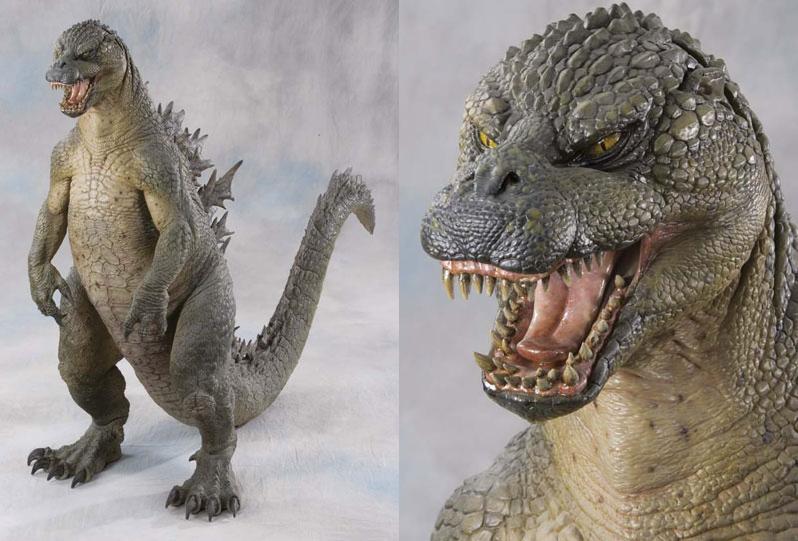The Americanization of Godzilla (Summative 2019)

Godzilla (or Gojira in Japan) is one of the largest Japanese media franchises ever. It is universally regarded as the father of the Kaiju (Japanese word for "Strange Creature) genre. Godzilla's titular character is a huge mascot all around the world as well, not just Japan.While the Japanese company Toho is responsible for most of the films and media featuring the character, both Godzilla and other Kaiju films have been attempted on numerous occasions by American studios.
Godzilla has left quite a large footprint in the West, with many of the Japanese films seeing releases with English dub-overs in the West, as well as multiple original features including the 1998 Godzilla and the new sort of “Monster Cinematic Universe” starting with the American 2014 Godzilla. Basically, the big guy has seen a lot of worldwide appearances, and it makes it extremely apparent the sort of effect that American cinema has had on foreign studios.
Let's start with original American kaiju films to see a Western take on the genre. The first American kaiju, and arguably the most iconic, is definitely the 1933 film; King Kong. King Kong even predates Godzilla, who arrived on Japanese screens 21 years later! King Kong is a massive multi-media icon even today, with the original film being referenced in hundreds of other media works! He even tried to feed Godzilla a tree!

That being said, King Kong is an obvious exception to the rule at least for his time. Many old school American kaiju films are remembered for being exceptionally poor, such as The Giant Claw (1957) and Ape (1976). Still, in the modern era of films, American studios have made a surprising comeback with films like Pacific Rim (2013) and Rampage (2018).
Getting back to Godzilla, what did American studios do with the most iconic giant monster in history? Many of the original Japanese Godzilla movies have been released in the west with both English dub-overs and the option to watch with original Japanese audio with subtitles. However, American studios never truly tried a fully original Godzilla film until the 1998 Godzilla, directed by Roland Emmerich. This film...Is not fondly remembered, in fact, even the average viewer disliked this movie. The 1998 Godzilla was a product of a deal between Toho and Tristar Pictures. So what happened?
This was the original design, as created by Stan Winston. This look for the creature looks very faithful in comparison to the original, only really ditching Godzilla's signature thunder thighs. This version of Godzilla was quickly scrapped when Emmerich came onto the project and was replaced by a horrific, weak-looking creature that everyone would later refer to as "Zilla" or "Gino", meaning Godzilla In Name Only.

Zilla is retarded as one of the weakest points in the franchise, being an extremely skinny and far smaller version of Godzilla. In fact, Zilla even spends most of the film running away from the American military. Director of the "Gamera" Kaiju series of films Shusuke Kaneko had some interesting insight when he said "It is interesting that the US version of Godzilla runs about trying to escape missiles...Americans seem to be unable to accept a creature that cannot be put down by their arms." The movie was critically panned and hated, Toho even held an extreme grudge, trying to discredit Emmerich's film. Not only did they immediately make a new movie just a year later, in the 2004 Godzilla: Final Wars, Godzilla could be seen destroying the Zilla from 1998. Needless to say, Toho was not very happy with Hollywood after that catastrophe.
So where does that bring us? With things quieting down, the next American studio to try their hand at a Godzilla film was Legendary Entertainment in 2014, releasing "Godzilla", a reboot of the series with a more serious tone. The movie was well-received, but also criticized for a lack of Godzilla actually being on screen. Still, it was quite faithful to the original, and the American design of Godzilla is quite loved by both Eastern and Western fans.
The unique thing about Godzilla 2014 is that it sparked a cinematic universe known as the "MonsterVerse". The MonsterVerse is an American kaiju universe, featuring faithful recreations of many famous monsters from different origins, such as Godzilla, Ghidorah, Mothra and even King Kong. With Kong: Skull Island being very well-received, we are brought to the most recent Godzilla film, the 2019 picture: Godzilla: King of the Monsters. The movie was extremely popular with audiences, much to the dismay of certain movie critics. The film featured a lot of exactly what fans wanted, monsters fighting eachother and destroying cities. The next film in the universe is slated to be Godzilla Vs. Kong in 2020, a supposed remake of the 1962 King Kong Vs. Godzilla.

It seems as though these two are going to be rivals until the end of time.
Godzilla has seen his ups and downs outside of Japan, but his fanbase is as large as he is. It seems as though American studios have grasped the true spirit of Godzilla. He is not just a big lizard. Godzilla can be both hilarious and terrifying. Mankind's destroyer or it's saviour. Godzilla is the king of the monsters and has been the most iconic film monster for decades. I personally loved the 2019 film, and look forward to Godzilla Vs. Kong. This new MonsterVerse has brought on a lot of interesting new ideas and monsters. Godzilla, to me, is a character and an icon that transcends his origins, making him a worldwide hit.



Comments
Post a Comment